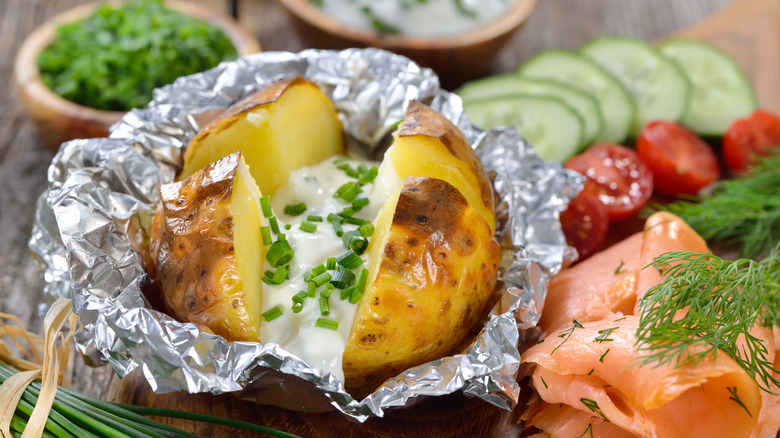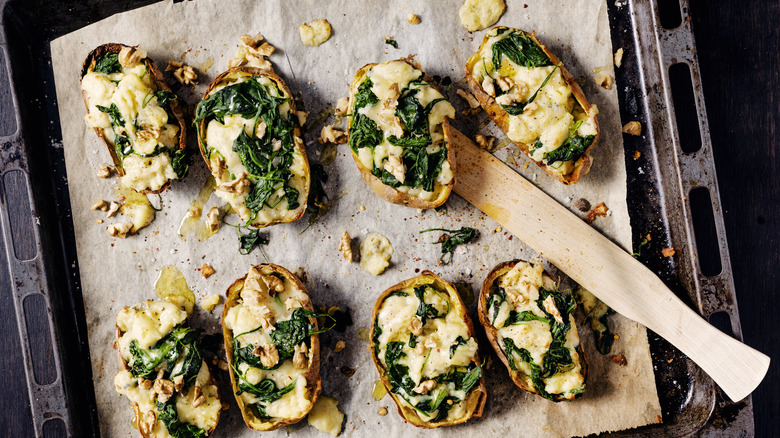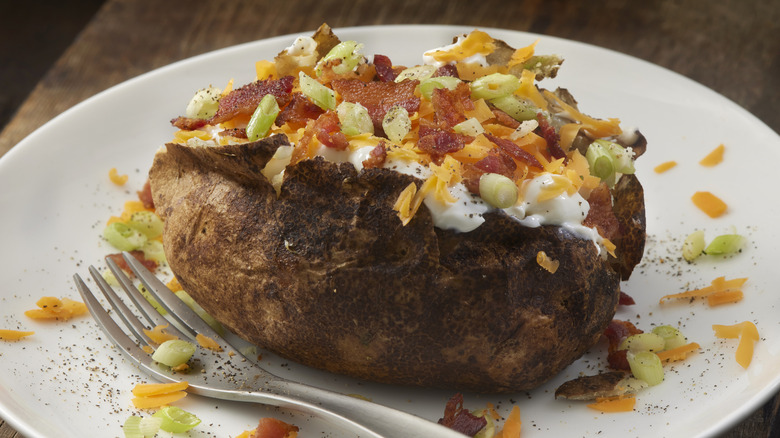Why Crispy Baked Potato Lovers Never Use Aluminum Foil
Nothing is as disappointing as a soggy baked potato; so far from the crispy-skinned, fluffy-on-the-inside spud that baked potato lovers seek out. But there's one seemingly standard practice in baked potato making that is sabotaging your final result, and that's aluminum foil. While it may seem standard to wrap your potato in this kitchen staple before popping it in the oven, it might prevent your potato from properly baking.
In addition to giving your potatoes soggy skins, baking your potato in foil can give your potato's interior a boiled texture, which isn't exactly what you're going for when making the delicious, starch-rich treat. For this reason, you won't catch any baked potato enthusiast putting an aluminum wrapping on their spud. Allowing your potato to cook in the open will give you the air and heat flow necessary for your potato to cook without trapping in excess moisture so that your potatoes fluff up rather than becoming a dense, soggy mess.
Keeping your spuds crispy
Although you will want to avoid baking your potatoes in aluminum foil, that doesn't mean that you need to avoid the metallic wrapping altogether. Wrapping your potato in aluminum foil after it's done cooking can be a good way to keep your potato hot. This is because aluminum foil is good at reflecting thermal energy, and can therefore keep your potato's thermal energy from escaping. But this is also why aluminum foil should not go on your spuds when baking, as the foil also traps moisture and steams your potato. And before you cover your cooked potatoes in foil, you should cut them open first, allowing steam to escape and prevent a dense, gummy potato interior.
So, while aluminum foil might seem like a must-have for potato baking, you will want to skip it (at least in the oven) to achieve the perfect potato skin texture. Instead of focusing on insulating your potato, let it cook in the open for better airflow. This will allow for even browning on all sides and a truly baked texture inside your spuds.
Other ways to improve your spuds
But nixing the aluminum foil isn't the only way to make your potatoes as crispy as possible. For one, you won't want to pop your potatoes in the oven while they're wet from their wash. Of course, you will want to rinse your spuds before baking, especially if you're planning on eating the skins. Doing so will remove any excess dirt from its exterior. You will want to do more than just give your potatoes a quick rinse; instead, make sure to scrub the skins thoroughly. After their scrubbing, you should pat your potatoes with a paper towel and allow them time to fully dry before putting them in the oven. This will prevent your potato skins from steaming.
Another way to make sure your potato skins are extra crispy is to cook your potatoes on a wire rack. This will prevent uneven cooking, and allow your potatoes to crisp on all sides since your potato won't be sitting on a flat surface. Additionally, cooking on a rack also allows for maximum airflow in the oven, meaning a crispier cook on your potato and incredibly delicious skins. But if you want to put a crunch on your skins, then you should opt to oil your potato skins before baking. You will also want to salt your skins for maximum flavor. And if you really want a crispy potato, you might want to try and twice-bake your potato.


